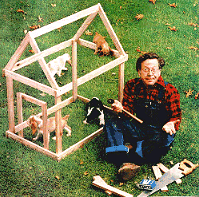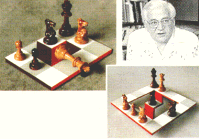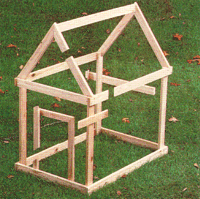 We're
all so used to
two-dimensional
drawings of solids, we don't give them a second glance. But if the artist
bends the rules, the result is a boggling double-take
We're
all so used to
two-dimensional
drawings of solids, we don't give them a second glance. But if the artist
bends the rules, the result is a boggling double-take
Psychology |
 We're
all so used to
two-dimensional
drawings of solids, we don't give them a second glance. But if the artist
bends the rules, the result is a boggling double-take
We're
all so used to
two-dimensional
drawings of solids, we don't give them a second glance. But if the artist
bends the rules, the result is a boggling double-take
The blueprint seems OK. Three threaded prongs fine, the machine shop can handle that. The metal casting should also be straightforward - two simple arms protruding from a square base. Just get the boss to initial it and send it on to the manufacturing plant.
|
Devil's pitcfork: a blueprint for
failure A classic "impossible figure" from the early 1960s. At first this object seems fine, with each part a recognisable, consistent shape; but it doesn't take long for the brain to clock that there's something amiss. As the eye travels along a line, the line imperceptibly changes function. |
But wait a minute. Take a closer look. When you try to get your mind
round the picture, things begin to fall apart.
Each end of the drawing makes sense, but when you try to integrate them you're
left with rather less than nothing. As for the nuts that are supposed to
fit on those prongs - the less said the better.
Welcome to the unsettling world of impossible figures. What you've
been looking at is a blueprint for the so-called "devil's pitchfork" - also
known as the two-pronged trident or the three- stick cleavis. Impossible
artists affectionately call it a "blivet", as in, it asks you to believe
it. But whatever you call it, you can't have one. The drawing is not of anything,
it simply exploits the way your brain tries to make three-dimensional sense
of what it is seeing in only two dimensions.
Impossible figures are a development of the simpler ambiguous figures,
which have several possible three-dimensional realities. Look at a set of
"baby blocks" carefully (see below left, middle). You'll probably see a pile
of boxes stacked in a corner - the shaded diamond-shapes represent their
tops. Look again, and with luck you'll experience a mental flip: the boxes
turn upside down and now they have dark bottoms.
Toying with the perceptions |
|
Look at the simple Necker cube (above) and watch it flip. Because there's no perspective, either side could be the nearer. At the next level of complexity, the "baby blocks" in the middle could be a stack of boxes on a floor, or hanging from the ceiling. Try turning the page through 45 degrees.In Roger Penrose's groundbreaking Impossible Tribar from the 1950s (above) each part is correct. But the whole triangle will get you in a twist. The first two are called "ambiguous figures"; the third is an "impossible" or "dimensionally challenged" figure. |
Look long and hard and you may see them as simultaneously stacked from the
ground and suspended from the ceiling. There are other interpretations too,
but don't look too long or you'll give yourself a headache.
Why are we fooled? When we look at any picture the brain instantly
processes the visual data and allow us to see a three- dimensional object
on a flat surface - although we know it cannot be there. That
illusion is common place -
and entirely beneficial. The art of painting depends on it for a start, as
do all areas of human endeavour where we need to convey a sense of three
dimensions on a piece of paper - which is practically everything we do.
 |
A DIY Nightmare? Prankster Walter is in the
doghouse
The American photographer and impossible
artist Walter Wick shrugs off his latest handiwork, the Kennel
of Confusion. This is the opposite of normal impossible figures: a
case of a three-dimensional representation of an impossible three dimensional
shape. Got that? |
But our brains didn't evolve to appreciate paintings, or blueprints
for that matter. They evolved to make life-saving judgments in a world where
it was vital to interpret often scant visual information very fast. Danger
or dinner? Fight or flee?

And it's our brains that sort out the information, not our eyes. Light
from the outside world strikes the retina in a pattern of varying brightness
and colour, but the pattern means nothing without the power of the brain
to process the signals that flash to it along the optic nerve.
That's quite a trick on the part of the brain. Technology has proved
very good at producing "artificial retinas" - devices for collecting information
from light. There's one in every video camera, and those used in advanced
models are vastly more sensitive than the ones in our eyes.
 |
Board to tears? These impossible chessboards would even make Gary Kasparov weep. Bruno Ernst (left),the world's leading Escher expert,adapted them from Lionel Penrose's Impossible Staircase. |
But making sense out of the patterns a retina detects is much harder:
programmers have had immense difficulty "teaching" even super-computers to
recognise quite simple images.
So it's not surprising that the human brain can sometimes be fooled. Where
and how it is fooled is a subject that greatly interests psychologists studying
how perception works. But people have been playing around with ambiguous
figures for far longer than psychologists have been explaining them. Designs
incorporating baby blocks are found on the floors of Romanesque churches
dating to the 10th century, and variations can be traced even further back.
Getting out of the DIY doghouse
The Wick's doghouse is of course an optical illusion
- not mind bending reality. |
 |
Two-dimensional space has been manipulated since the earliest cave
paintings to give an approximation of 3-D space, but it wasn't until half-way
through the present century that artists thought of taking it as their subject
matter. The Surrealists, in the 1930s and '40s, delighted in using ambiguous
and impossible figures to draw attention to the absurdity of the "modern
condition".
The first person to write about ambiguous figures was L A Necker , a mineralogy
professor from Geneva, who described the
"Necker cube" in 1832. This is
simply a wire-frame cube, drawn from an angle and without perspective, and
it has the same effect on our perception as the blocks. The "front" corner
flips to become the "back" corner and vice versa. In other words, there are
at least two solutions to the perceptual question "what is it?".
As 19th-century interest in perception grew, more ambiguous figures
were developed. One major if elementary discovery was the effect of shadow
a picture of a sun-lit mound appears to be a hollow when turned over - and
the crucial role light and shade play in art. In effect, visual clues are
interpreted by the brain in a programmed way - which can be tricked remarkably
easily.
|
Convex and Concave (above left) employs the same principle
as the blivet: the two sides are correct and it's the joining up that creates
the inconsistency.
Where the blivet spreads its connection over some distance (so
the eye has trouble seeing the two ends simultaneously), Escher placed the
two parts beside each other, skilfully using shade to fudge the join. Note
the baby blocks on the hanging banner.
Waterfall (above),three tribars joined together is a
perplexing contribution to the perpetual motion debate.
|
|
| MC Escher - founding father of a special school of art | ||
After World War ll the Dutch artist Maurits Cornelis Escher (1898-1972) began drawing his "impossible figures" , which have become some of the best - known images of our time.
|
||
It is a small step from the Necker cube to the truly impossible "tribar"
, though that step took more than a century. The figure seems to have been
invented twice: once, in 1934, by the Swedish art historian Oscar
Reutersväard (with a bubble) ; and again, quite independently in 1958
by Roger Penrose, now Sir
Roger, an Oxford mathematics professor and author of
The
Emperor's New Mind.
Figuring the impossible |
||
|
||
|
||
| A knotty problem
A impossible
fourbar is more fiendish when it is intersected by a possible
cross Up the impossible staircase to nowhere The eye takes its cue from the most obvious fact,here that the steps must be coming up out of the hole in the ground.The first storey cannot be flat Another one that doesn't quite square The individual corners of a cuboid can be combined into impossible forms A mad spiralling thing In this spiral the illusion that all the lines are straight gets you into trouble.A variety on the impossible cuboid theme. |
More subtle than the blivet, the Tribar has three linked sections
(some variants have even more), and any two of the links make perfect sense.
It is only when the eye follows the loop all the way round to the third link
that the inconsistency leaps out. The Tribar has become a familiar image
in commercial logos and other graphics helped by the fact that Penrose, not
foreseeing how popular it would become never copyrighted his design.
Put the Necker cube together with the Penrose tribar, add some skilful
photography, and you get the apparently three-dimensional dog kennel on the
previous page. Created by American prankster William Wick back in the early
1980s, it too is impossible. The clues the brain uses to reconstruct a solid
image from a flat picture have been cunningly manipulated, and added to real
three dimensional red herrings, until the mind boggles at the contradictions
it is being asked to accept.
Are impossible figures an art form, or a research tool for psychologists?
Both, of course. But as the master of creating art from optical paradox,
M C Escher shows us, there's no need to
get tied up in knots about them.
David Singmaster